

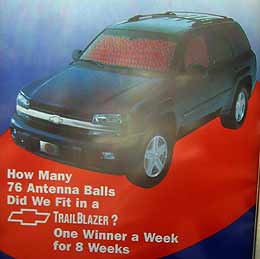 How
much is inside a Chevy Trailblazer? How
much is inside a Chevy Trailblazer?
"One yuppie and a six pack of Sierra Nevada Pale Ale", would be the answer most people would give, and they would be right. I, however, was motivated to find a more precise answer by a contest at my local Unocal 76 gas station. I don't usually buy gas at 76, but I was riding with Steve and Elise, so I noticed the sign when we stopped to fill up. How many 76 antenna balls did we fit in a Chevy Trailblazer? The sign asked. They were giving away eight new trucks, worth $26,000 each to the eight people that guessed the closest, without going over. I decided to try my luck. Who could be better at figuring out "how much is inside" than I, Rob Cockerham, experienced internet quantifier and volume-showman? |
 The
question intrigued me. Spheres filling a volume is hard enough to
calculate, but also trying to figure out the interior volume of the truck
made the prospect daunting. Both answers would be hard to determine, and
both could have wide margins of error. The
question intrigued me. Spheres filling a volume is hard enough to
calculate, but also trying to figure out the interior volume of the truck
made the prospect daunting. Both answers would be hard to determine, and
both could have wide margins of error.
The difficulty of determining an accurate answer actually motivated me. How many people would take the time to calculate an answer? All I had to do was to out-calculate (or out-guess) the other people in California and Nevada. Sure, there are some brilliant scientists in California, I heard they are even building a University here, but I figured anyone with REAL calculating skillz would be working on the US fiscal policy in Washington D.C. |

I peeled off an entry form and studied it on the trip. Contest scientists had filled a 2002 Chevy Trailblazer with 76 antenna balls (not including the glove compartment and center console). There were eight separate, consecutive weekly contests to see who could guess the closest number without going over. Entries had to be mailed in, one at a time, in separate envelopes. Whatever week the entry arrived would determine which contest it was in. My first thought was that the truck could probably hold about 6,000 balls. Eager to get started, I bought an antenna ball the next day & measured it. Remarkably, the 76 station does not give away these hard styrofoam balls, they sell them for 89¢. |
 Last
winter I studied ball arrangements in Bulgaria,
so I knew that a lot of research had already been done on balls. Something
I realized immediately was that when you pack balls into a space, a lot of
room gets wasted in between the balls. Last
winter I studied ball arrangements in Bulgaria,
so I knew that a lot of research had already been done on balls. Something
I realized immediately was that when you pack balls into a space, a lot of
room gets wasted in between the balls.
I had to figure out how much of the Trailblazer space would have been wasted. I'll refer to the space that balls occupy as Ball-Space, and the volume that is left over between the balls as Air-Space. I looked up ball stacking on the internet and immediately found the answers I was looking for: I found Amy C. Edmondson's Site regarding R. Buckminster Fuller ball-geometry. |
 That
site explained that the tightest arrangement of spheres resulted in 77.96%
ball-space and 21.04% air-space. This requires careful packing of the
spheres into shapes called tetrahedral groups. That
site explained that the tightest arrangement of spheres resulted in 77.96%
ball-space and 21.04% air-space. This requires careful packing of the
spheres into shapes called tetrahedral groups.
Well, you and I both know that spheres can't pack tetrahedrally in an indefinite array, and we also know that the 76 antenna ball contest-scientists didn't carefully stack the balls in the truck, they dumped them in with a bucket and two plastic shovels. How many balls can you fit in a space if you just dump them in? I needed to conduct a random ball-packing experiment to simulate the safe, quiet environment of the 2002 Chevy Trailblazer. |
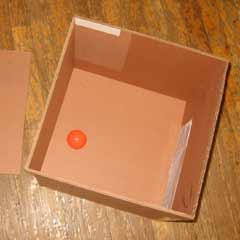 To
find the answer to this problem, I carefully built a one-cubic foot
cardboard box. To
find the answer to this problem, I carefully built a one-cubic foot
cardboard box.
Filling it with antenna balls would have taken all day (and about $300), so I brought the box down to my local Wishing Well (party-supply) store, where they allow anyone off the street to come and handle their balls. The ping-pong balls are much smaller than 76 antenna balls, with only a 1.45" diameter, but I could still use them because I was trying to figure out the percentage of space the balls wasted when they are dumped into a box instead of being carefully stacked. |
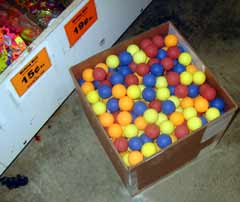 I
used nearly every ping-pong ball they had, filling my box to the upper
edge. The 1728 in³ box was filled with air and balls. I
used nearly every ping-pong ball they had, filling my box to the upper
edge. The 1728 in³ box was filled with air and balls.
I counted out 577 ping-pong balls. The volume of one ping-pong ball is area 1.59 in³ which means that only 53% of the box was ball-volume! 810 in³ were air. This was nowhere close to the 78% ball-space I had read about online. I was beginning to think I had a special edge in the contest. |
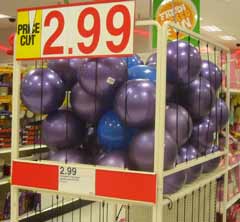 On the way home from Wishing Well, I stopped at Target and found a large
sphere-packing experiment there too.
On the way home from Wishing Well, I stopped at Target and found a large
sphere-packing experiment there too.
These soft inflated balls packed a little closer to each other, but the box was pretty small compared to size of the 904in³ balls. Only 38% of the cage volume was filled with ball volume. The rest was wasted retail space! Once I had deflated the balls with an ice-pick from housewares, they packed much closer, leaving room for a hundred more balls. I tried explaining tetrahedral groups to the security guards, but those guys couldn't see a octahedral cluster if it hit them in the face!
|
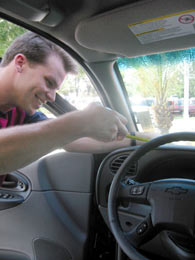 With
some reliable sphere-packing numbers backing me up, I needed to ascertain
the interior volume of a 2002 Chevy Trailblazer LE. With
some reliable sphere-packing numbers backing me up, I needed to ascertain
the interior volume of a 2002 Chevy Trailblazer LE.
I had some trouble coercing anyone into accompanying me to a car dealership. Hanging out at a car dealership being shadowed by salesmen isn't exactly how sane people spend their free time. Finally, on Monday I coerced Elise into driving me to Maita Chevrolet in the Elk Grove Auto Mall. I even promised her $1,000 of the prize money if I won. I asked the salesmen if it would be OK to measure the HELL out of a 2002 Chevy Trailblazer, explaining that I was trying to win a contest. They were very supportive and friendly, understood that we didn't want to buy one, and generally left us alone to measure every detail of this brand new car.
|
 I worked with a tape measure for about an hour, taking notes and drawing
sketches of interior details.
I worked with a tape measure for about an hour, taking notes and drawing
sketches of interior details.
The interior was very complicated, so I tried to treat each element as a squared-off version of itself. I knew I was going to be calculating the interior volume and then subtracting items from the interior, such as the dashboard, the seats, and the center console. I averaged distances and made some generalizations. My contact at Hyundai is going to be VERY interested in the information I gathered!
|
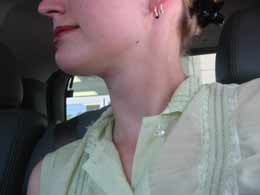 Elise
found the flip-down LCD screen for the DVD player. I guess it has been
awhile since either one of us has been in a fancy new car, because we were
pretty impressed. Elise
found the flip-down LCD screen for the DVD player. I guess it has been
awhile since either one of us has been in a fancy new car, because we were
pretty impressed.
The 8 winners of this contest would have the option of taking $20,000 in lieu of the Chevy Trailblazer. I had planned on taking the money, but spending an hour inside the plush Trailblazer was making me question my decision. It would be pretty nice to cruise around in this thing... Then again, $20,000 buys a lot of lap dances. |
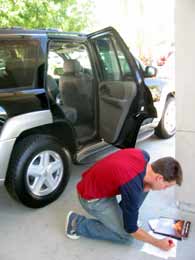
From time to time a salesman would pop out of the office and offer us additional information. "The brochure says it has 80 cubic feet of cargo", "This model has leather seats, which are going to be different from the cloth seats on the LE". I think they thought my mission was madness, but that didn't stop them from helping. They also gave me a 18-page glossy brochure. This was not the experience I expected from a car dealer. I was pleasantly surprised. I made a mental note to reward the car salesmen if I won the money. |
|
|
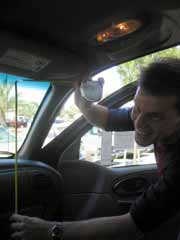
A popular question among my friends was "did you measure the space under the seats?". I assured them that I had. |
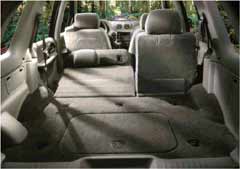 Armed
with piles of raw data, I went home and started calculating the space
inside the truck. Armed
with piles of raw data, I went home and started calculating the space
inside the truck.
There was a front section, a middle section, and a rear cargo area.
|
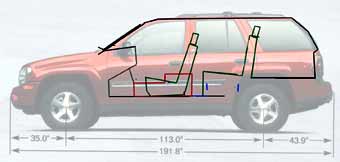 Using
an side-view image of the trailblazer with accurate measurements, I drew a
rough outline of the interior boundaries and features. My measurements had
not been entirely comprehensive, but I could calculate any unknown distances. Using
an side-view image of the trailblazer with accurate measurements, I drew a
rough outline of the interior boundaries and features. My measurements had
not been entirely comprehensive, but I could calculate any unknown distances.
|
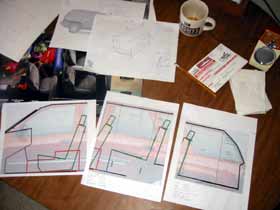 Next
I dropped a layer of tiny squares over the outline in photoshop. I reduced
the grid until it accurately represented square-inches in the image. Next
I dropped a layer of tiny squares over the outline in photoshop. I reduced
the grid until it accurately represented square-inches in the image.
To find the area of the cross section, I just counted the squares.
|
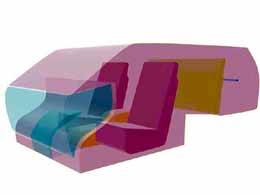 I
performed similar calculations on the rear-view and top-view to form a 3 dimensional
model of the Chevy Trailblazer. I
performed similar calculations on the rear-view and top-view to form a 3 dimensional
model of the Chevy Trailblazer.
It didn't really help my calculations, but I felt compelled to draw (a slightly less-accurate) one in 3D Studio Max as well. You can see where I cut corners on the details of the interior, leaving out the foot pedals, roof console and martini shaker. The numbers boiled down to my one beautiful answer: 125.5 cubic feet of interior volume. |
 Now
I could calculate an answer. Now
I could calculate an answer.
I had already figured that a large, loose-packed box of a spheres wastes about 44% of the space with air, leaving 56% of each square foot of volume for actual ball-volume. Therefore each cubic foot would have 967 cubic inches to hold antenna balls. |

Next I figured out how many antenna balls would fit in each cubic foot of area: 295. Damn, look at all this math! |
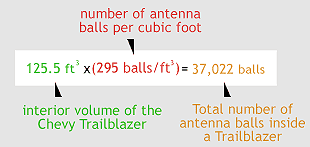
Finally, I multiplied the number of cubic feet in the Trailblazer to the number of balls that could fit in each cubic foot, for a grand total of 37,022 antenna balls. I had my answer! This number was much larger than my original guess of 6,000.
|
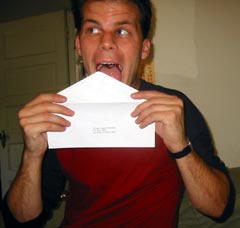
Armed with a solid, somewhat unexpected number, I rushed to fill out entry forms. The contest had eight separate deadlines for their eight $20,000 prizes. I had already missed the first four weeks of contest, but I felt good about my chances in the remaining four weeks. The entry forms had to be filled out by hand, but I printed the envelopes.
|
 The
cost of each entry was a 37¢ stamp, so I decided to mail in 25 entries in
each of the next four weeks, for a total of 100 entries. The
cost of each entry was a 37¢ stamp, so I decided to mail in 25 entries in
each of the next four weeks, for a total of 100 entries.
I staggered each entry form away from my cardinal guess of 37,022 in a bell curve, down to a few thousand and up a few thousand.
|
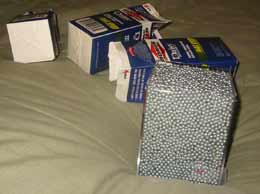 Between
the first week and the second week I performed a few more experiments with
loose-packed balls. Between
the first week and the second week I performed a few more experiments with
loose-packed balls.
These BBs packed marvelously into this small plastic box, taking up about 59% of the volume. The more walls and obstacles the balls had to arrange themselves around, the more space was wasted. I had to gauge where the soft, welcoming environment of the Trailblazer would compare to these boxes. Mike suggested I build a scale model of the trailblazer to fill with marbles or ball-bearings. This was an excellent idea, but right after I built it, I locked the keys inside. |
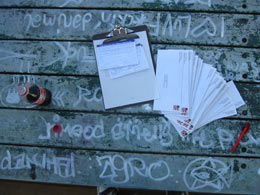 Each
Wednesday I would fill out and mail 25 entry forms. They asked for my
address, phone number and for which gas station I got the entry. Each
Wednesday I would fill out and mail 25 entry forms. They asked for my
address, phone number and for which gas station I got the entry.
For good luck during this time I only drank gasoline from Unocal 76 stations. Who else had a better guess than me? That is the question I grappled with. The winner would be the person who guessed closed to the correct number without going over. I had 4 chances, four separate batches of contest entries. |
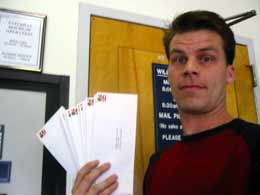 My
contest excitement grew as the "Winners will be notified by mail on
or about August 9th" date approached. I was working making displays
for the California State Fair at the time, dreaming of fancy new clothes
and exotic vacations. My
contest excitement grew as the "Winners will be notified by mail on
or about August 9th" date approached. I was working making displays
for the California State Fair at the time, dreaming of fancy new clothes
and exotic vacations.
Twenty thousand dollars is an absurd cash-influx into a young man's life. On August 7th, two days before the winners were to be notified, I decided to check the 76 union gas station website.
|
| Please read Part 2, where the question JESUS CHRIST ROB! DID YOU WIN?!?!! is answered |
Home | How much is inside other stuff? | Contact Rob | Staff Page
Two images on this page are from and copyrighted by Chevrolet.
Last updated Sept. 12, 2002.